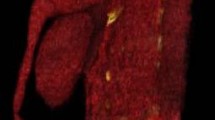Abstract
Splenogonadal fusion is a rare congenital malformation in which there is an abnormal fusion between the spleen and the gonad or derivatives of the mesonephros. It can occur in both sexes but has been reported far more frequently in males. There are two types of this malformation: the continuous and the discontinuous type, depending on the presence or absence of a structural connection between the regular spleen and the ectopic splenic tissue that is fused to the gonad. In one-third of all reported cases splenogonadal fusion is associated with other congenital defects. This association is predominantly found within the continuous type. Peromelia is present in a high percentage of cases, varying from total absence of all limbs to absence of parts of the lower limbs.
On the basis of a case report and a review of 84 published cases, the causal, pathogenetic and nosologic aspects of this malformation are discussed. We hypothesise that splenogonadal fusion with peromelia and splenogonadal fusion without peromelia represent two ends of one spectrum determined by the developmental stage during which the causal factor acts.
Similar content being viewed by others
References
Almenoff IA (1960) Splenic-gonadal fusion. NY State J Med 66: 1679–1681
Bersu ET, Pettersen JC, Charboneau WJ, Opitz JM (1976) Studies of malformation syndromes of man XXXXIA: Anatomical studies in the Hanhart syndrome—A pathogenetic hypothesis. Eur J Pediatr 122:1–17
Falkowski WS, Carter MF (1980) Splenogonadal fusion associated with an anaplastic seminoma. J Urol 124:562–564
Fritzsche F (1956) Lien caudatus mit eigenartiger Implantation des oberen Milzpols in die Leber. Virchows Arch [Pathol Anat] 329:35–45
Given HF, Guiney EJ (1978) Splenic-gonadal fusion. J Pediatr Surg 13:341
Gordeef J, Cuennant J (1951) Rate surnuméraire à localisation scrotale. Maroc Méd 30:744
Gray's Anatomy (1980) Peter L. Williams, Roger Warwick (eds), 36th edn. Churchill Livingstone, Edinburgh
Guarin U, Dimitrieva Z, Ashley SJ (1975) Splenogonadal fusion —a rare congenital anomaly demonstrated by 99m TC-sulfurcolloid imaging: a case report. J Nucl Med 16, 10:922–924
Halvorsen JF, Stray O (1978) Splenogonadal fusion. Acta Paediatr Scand 67:379–381
Hannak H (1966) Über Strangbildungen zwischen Milz und Hoden sowie Nebenmilzen im Scrotum. Chirurg 37, 1:37–40
Herrmann J, Pallister PD, Gilbert EF, Viseskul C, Bersu E, Pettersen JC, Opitz JM (1976) Studies of malformation syndromes of Man XXXXI B: Nosologic studies in the Hanhart and the Möbius syndrome. Eur J Pediatr 122:19–55
Hines JR, Eggum PR (1961) Splenic gonadal fusion causing bowel obstruction. Arch Surg 83:887–889
Von Hochstetter A (1953) Milzgewebe im linken Ovarium des linken Individualteiles eines menschlichen Thoracopagus. Virchows Arch 324:36–54
Kalter H, Warkany J (1982) Congenital malformations (second of two parts). N Engl J Med 308:491–497
Lenz W (1980) Approaches to classification of limb defects. In: Merker H-J, Nau H, Neubert D (eds) Teratology of the limbs. Walter de Gruyter and Co., Berlin New York, pp 413–415
Loomis KF, Moore GW, Hutchins GM (1982) Unusual cardiac malformation in splenogonadal fusion-peromelia syndrome: relationship to normal development. Teratology 25:1–9
May JE, Bourne CW (1974) Ectopic spleen in the scrotum: report of 2 cases. J Urol 111:120–123
McKusick VA (1983) Mendelian inheritance in man. Splenogonadal fusion with limb defects and micrognathia, 6th edn. John Hopkins Univ. Press, Baltimore, p 491
McNamara JJ (1969) Splenic-gonadal fusion: case report. Pathology 1:331–332
Moore KL (1977) The developing human. Saunders, Philadelphia, USA
Nikolajew NW, Dergatschew JS (1927) Ein Fall von seltener kombinierter Mißbildung. Zeitschr Kinderheilkd 44:406–410
Pauli MR, Greenlaw A (1982) Limb deficiency and splenogonadal fusion. Am J Med Genet 13:81–90
Poidevin LOS (1953) Amelia, review of the literature and report of a case. J Obst Gynaec Brit Emp 60:922–926
Putschar WGJ, Manion WC (1956) Splenic gonadal fusion. Am J Pathol 32:15–33
Rosenthal JT, Bedetti CD, Labayen RF, Christy WC, Yakulis R (1981) Right splenogonadal fusion with associated hypersplenism. J Urol 126:812–814
Skworzoff M (1924) Zur Frage über den descensus testiculorum bewerkende Kräfte. Virchows Arch [Pathol Anat] 250:636–640
Sommer JR (1958) Continuous splenic gonadal fusion with ectromelia: teratogenesis, a case report. Pediatrics 22:1183–1189
Watson RJ (1968) Splenogonadal fusion. Surgery 63 (5):853–858
Author information
Authors and Affiliations
Rights and permissions
About this article
Cite this article
Gouw, A.S.H., Elema, J.D., Bink-Boelkens, M.T.E. et al. The spectrum of splenogonadal fusion. Eur J Pediatr 144, 316–323 (1985). https://doi.org/10.1007/BF00441771
Received:
Accepted:
Issue Date:
DOI: https://doi.org/10.1007/BF00441771




